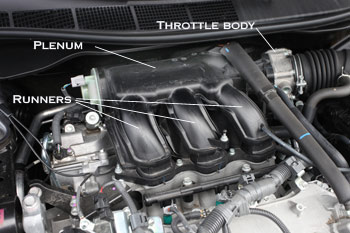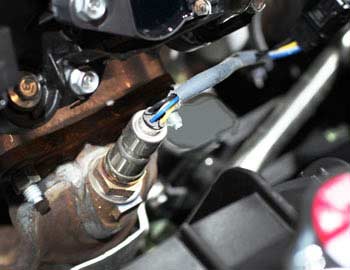Intake manifold, how it works, problems, replacement cost
Updated: August 01, 2021
The intake manifold in a car is the part of the engine that distributes the air flow between the cylinders.
Often an intake manifold holds the throttle valve (throttle body) and some other components. An intake manifold consists of the plenum and runners, see the photo. In some V6 and V8 engines, an intake manifold can be made of several separate sections or parts. How the intake manifold works: The intake air flows through the air filter, intake boot (snorkel), then through the throttle body, into the intake manifold plenum, then through the runners and into the cylinders (see diagram).
The throttle valve (body) controls the engine rpm by adjusting the amount of air flow. In modern cars, the engine idle speed is also controlled by the throttle body: at idle, it opens at a very small angle. Because the throttle body is almost closed when the engine runs at idle, there is vacuum inside the intake manifold. If there is a vacuum leak somewhere in the manifold, the engine will run rough at idle. Many of the problems with intake manifolds are related to vacuum leaks, read more below.
The engine performance can be adjusted by varying the size of the intake plenum and the length or opening size of the runners. For this reason, modern cars have variable intake manifolds where special tuning valves change the air flow through the manifold depending on the engine speed and power demand.
Intake manifold problems
Common problems with intake manifolds include vacuum, coolant or oil leaks, reduced flow due to carbon build-up and issues with the intake tuning valves. In some engines, an intake manifold can corrode or crack causing either vacuum or coolant leaks. A cracked manifold must be replaced if it cannot be safely repaired.Coolant leaks: In some cars, there are coolant passages inside the intake manifold that can leak, often because of bad gaskets or other damage. For example, this problem was fairly common in older GM V6 engines. If the manifold is not damaged and mating surfaces are in good shape, replacing the gaskets or re-sealing the manifold is usually enough to solve the problem. If the manifold is damaged, it must be replaced.
Vacuum leaks: Worn-out intake manifold gaskets (in the photo) often cause vacuum leaks. This can cause rough idle, stalling, as well as the Check Engine light coming on, although the engine may run fine at higher rpm. For example, the OBD-II trouble codes P0171 and P0174 are often caused by intake manifold vacuum leaks. If the leaks are caused by bad gaskets, the repair involves removing the intake manifold, checking and cleaning the mounting surfaces and replacing the gaskets. See, for example, these YouTube videos of this repair in a Ford V6 engine.
Often the source of the vacuum leak could be a cracked vacuum hose or line that connects to the intake manifold. In this case, a broken vacuum hose or line must be replaced. Sometimes an intake manifold can warp causing the gaskets not to seal properly. A warped intake manifold must be replaced. In some cars, a vacuum leak can be identified by a hissing sound coming from under the hood. Read more: Vacuum leaks: common sources, symptoms, repairs.
Carbon buildup: In some engines, for example, Volkswagen TDI Diesel, carbon build-up inside the intake manifold, can cause a lack of power, misfiring, smoke and poor fuel economy. Issues with carbon buildup are more common in turbocharged engines. One of the main symptoms is a lack of power. A clogged-up intake manifold might need to be removed and cleaned manually. In some cases, replacing the intake manifold might be a more sensible solution than cleaning it. There are many hidden areas inside the manifold that cannot be cleaned.
Problems with Intake manifold tuning valves
Tuning valves are typically operated by electric or vacuum actuators. Often, a rubber diaphragm inside a vacuum actuator starts leaking and the actuator stops working. It's easy to test the vacuum actuators with a handheld vacuum tester.
How to test vacuum actuators for tuning valves.
If a vacuum actuator leaks, it must be replaced. See this video on how to test the vacuum actuators of the intake manifold tuning valves. The vehicle computer (PCM) engages vacuum actuators by turning little vacuum control solenoids on and off. These solenoids also often go bad. Solenoids are also easy to test with a handheld vacuum pump.
Another common problem is when the runner control valve or tumble valve is sticking due to carbon buildup or when a valve is warped. In this case, the manifold must be replaced.
For example, problems with the intake manifold (runner control valve) are common in some VW/Audi engines. Volkswagen extended the warranty on intake manifold for certain 2008-2011 Model Year Audi/Volkswagen Vehicles with 2.0 TFSI Engine Engine Codes CBFA & CCTA. Read more at this forum.
In many BMW vehicles a failed DISA valve installed in the intake manifold is also a common issue. See these videos about DISA valve repair in BMW.
Intake manifold replacement
If the intake manifold cannot be cleaned or repaired, it must be replaced. An intake manifold is also replaced if one of the failed tuning valves cannot be replaced separately. IReplacing an intake manifold in a an average car with 4-cylinder engine is not very difficult. For example, a dealer may charge you about 1.9-2.0 hours of labor (plus the part) to replace the intake manifold in the 2011-2016 Chevrolet Cruze 1.4L turbo.
Replacing the intake manifold in the 2009 BMW 335i in the shop will cost around 3 hours of labor plus parts.
When replacing an intake manifold, it's important to clean the mounting surface, replace the gaskets, verify that all the hoses and lines are properly connected and torque the manifold bolts in the recommended order to specs.
Read Next:
Vacuum leaks: problems, symptoms, repairs
Check Engine light: what to check, common problems, repair options
Code P0171 - System Too Lean: symptoms, causes, common problems, diagnostic
Mass Air flow Sensor (MAF): how it works, symptoms, problems, testing
Codes P0301-P0308 Cylinder Misfire Detected: symptoms, common problems causing misfire, repairs
Vacuum leaks: problems, symptoms, repairs
Check Engine light: what to check, common problems, repair options
Code P0171 - System Too Lean: symptoms, causes, common problems, diagnostic
Mass Air flow Sensor (MAF): how it works, symptoms, problems, testing
Codes P0301-P0308 Cylinder Misfire Detected: symptoms, common problems causing misfire, repairs




